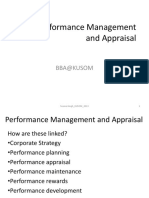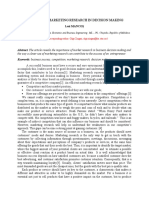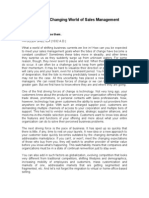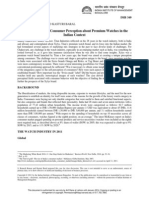Chapter - 5 Measuring Market Opportunities
Chapter - 5 Measuring Market Opportunities
Uploaded by
Zeynab AbrezCopyright:
Available Formats
Chapter - 5 Measuring Market Opportunities
Chapter - 5 Measuring Market Opportunities
Uploaded by
Zeynab AbrezOriginal Description:
Original Title
Copyright
Available Formats
Share this document
Did you find this document useful?
Is this content inappropriate?
Copyright:
Available Formats
Chapter - 5 Measuring Market Opportunities
Chapter - 5 Measuring Market Opportunities
Uploaded by
Zeynab AbrezCopyright:
Available Formats
Measuring Market Opportunities: Forecasting and Market Knowledge
Chapter 5
A Forecasters toolkit Statistical and other quantitative methods
Statistical methods use past history and various statistical techniques, such as multiple regression or time series analysis, to forecast the future based on an extrapolation of the past. Not useful for entrepreneurs. In established firms, for established products, statistical methods are extremely useful.
Limitations of S & Q methods
As with all forecasting methods, statistical methods have limitations. Most important one is that they generally assume that future will look very much like past. If product or market characteristics change, statistical models used without adequate judgment may not keep pace.
Observation.
This method is to directly observe or gather existing data about what real consumers do in the product market of interest. Observation based forecasting is attractive because it is based on what people actually do. If data can be found from existing secondry sourcesin company files, at the library, or on the internetdata collection is both faster and cheaper than a new study, from scratch. Does not apply to new products.
Surveys or Focus Groups
These surveys can be done with different groups of respondents. Consumers after being shown a statement or a prototype or sample of the product, can be asked how likely they are to buy, creating a survey of buyers intentions. The sales people can be asked how much they are likely to sell, completing a survey of sales force opinion.
Limitations of Focus groups
What people say is not always what people do. The persons who are surveyed may not be knowledgeable. What people imagine about a product concept in a survey may not be what is actually delivered once the product is launched.
Analogy
Used when neither statistical method nor observations are possible to forecast the sales or market potential for a new product . Then in such case analogy is used. Under this method, the product is compared with similar products for which historical data are available. Limitation is that new product is never exactly like that to which the analogy is drawn.
Judgment
Sometimes forecasts are made solely on the basis of experienced judgment or intuition. Some decision makers are intuitive in their decision processes and cannot always articulate the basis for their judgments. Those sufficient forecasting experience in a market they know well, may be quite accurate in their intuitive forecasts. As a limitation judgment cannot be defended compared to evidence-based methods, when the two differ.
Market test
Market tests of various kinds are the last of our most commonly used methods. Used largely for new products, market tests such as experimental test markets may be done under controlled experimental conditions in research laboratories, or in live test markets with real advertising and promotion and distribution in stores.
Mathematics entailed in Forecasting
The combination of judgment and other methods often leads to the use of either of two mathematical approaches to determine the ultimate numbers: the chain ratio calculation or the use of indices.
Rate of diffusion of innovations
This theory seeks to explain the adoption of an innovative product or service overtime among a group of potential buyers. This is particularly useful for entrepreneurs or other marketers to see if the investment in development and introduction of the new product will be adopted by the target market or not. This is useful to mangers in predicting the adoption rate.
The adoption process
This involves the attitudinal changes experienced by individuals from the time they first hear about a new product , service, or idea until they adopt it. Some tend to adopt early, some late, and some never.
Five stages of adoption process
1.
2.
3.
Awareness. In this stage the person is only aware about the product, and is motivated to seek information about the product. Interest. Here individual is sufficiently interested in it but has not yet involved. Evaluation. Here the individual is mentally applying the product to his own requirements and anticipating the results.
Five stages of adoption process
4. Trial. Here the individual actually uses the product, but will not yet adopt it. 5. Adoption. In this stage the individual not only continues to use the new product but also adopt it.
The rate of adoption
Those who adopt a product go through the five stages in adoption process. 1. The risk , cost of product failure or dissatisfaction. 2. The relative advantage over other products. 3. The relative simplicity of the new product. 4.Its compatibility with the previously adopted ideas and behavior.
The rate of adoption
5. The extent to which its trial can be accomplished on a small scale basis. 6. The ease with which the central idea of the new product can be communicated.
Adopter categories
Using time of adoption as a basis for classifying individuals, five major groups can be distinguished: Innovators. Early adopters Early majority Late majority Laggards.
These adopter groups can be considered market segments. One would use a different set of strategies to market a new product to the early adopter group than to market it to the late majority group. Commercial sources are most important at the awareness stage in the adoption process, while personal influence is most important at evaluation stage. In the interest stage both are important. In trial stage marketers should facilitate the prospect to try the product .
Implications of diffusion of innovation theory
A good way to estimate how quickly an innovation is likely to move through the diffusion process is to construct a chart that rates the adoption on the six key factors influencing adoption speed. View Exhibit 5.7
Keys to good forecasting
The first key is to make explicit the assumptions on which the forecast is based. This way if there is debate or doubt about the forecast, the assumptions can be debated, and data to support the assumptions can be obtained.. The second key is to use multiple methods. When forecasts obtained through different methods, converge near a common figure, greater confidence can be placed in that figure.
Sources of error
Forecasters are subject to anchoring bias, even though market conditions have changed . Capacity constraints are sometimes misinterpreted as forecasts. Incentive pay can be a source of bias in forecasting. Implicit assumptions can overstate a well intentioned forecast.
Market knowledge systems
Internal record systems. Marketing databases. Competitive intelligence systems. Client contact and sales force Automation systems.
You might also like
- The Dissertation Journey A Practical and Comprehensive Guide To Planning PDFDocument6 pagesThe Dissertation Journey A Practical and Comprehensive Guide To Planning PDFPayToWritePaperUKNo ratings yet
- Meta Marketing: Presented byDocument9 pagesMeta Marketing: Presented byDevkant Rath67% (3)
- Legal and Administrative Issues in CompensationDocument36 pagesLegal and Administrative Issues in CompensationCherianXavier100% (1)
- Sears Auto CentersDocument4 pagesSears Auto CentersZeynab AbrezNo ratings yet
- Unit 7 Strategic Marketing MGTDocument10 pagesUnit 7 Strategic Marketing MGTmikeNo ratings yet
- Consumer BehaviourDocument10 pagesConsumer BehaviourPranayNo ratings yet
- Targeting Attractive Market SegmentsDocument20 pagesTargeting Attractive Market SegmentsNur Shiyaam100% (1)
- International Business: Country Evaluation and SelectionDocument36 pagesInternational Business: Country Evaluation and SelectionHuman Resource Management100% (1)
- MB0052Document229 pagesMB0052Ashwani K SharmaNo ratings yet
- Methods To Initiate Ventures From Idea To ActionDocument2 pagesMethods To Initiate Ventures From Idea To ActionEC Virtual DeskNo ratings yet
- Module 2 Innovation As A Core Business ProcessDocument33 pagesModule 2 Innovation As A Core Business ProcessBruno SaturnNo ratings yet
- WeLike Project HPGD JA20 0250Document52 pagesWeLike Project HPGD JA20 0250dsfmkdslNo ratings yet
- Indian Marketing EnvironmentDocument9 pagesIndian Marketing EnvironmentRaju VeluruNo ratings yet
- Assessment Criteria Grade S/U Comments: Corel: Reworking The StrategyDocument20 pagesAssessment Criteria Grade S/U Comments: Corel: Reworking The StrategyVincent ChianNo ratings yet
- Territory ShapesDocument3 pagesTerritory ShapesThein HtutNo ratings yet
- Marketing 4.0 MCQDocument8 pagesMarketing 4.0 MCQVivek MuthaNo ratings yet
- Interpersonal Dynamics of Industrial Buying BehaviourDocument10 pagesInterpersonal Dynamics of Industrial Buying BehaviourReema Frank DsouzaNo ratings yet
- Startup and New Venture ManagementDocument10 pagesStartup and New Venture ManagementVinod JakharNo ratings yet
- 4, Understanding Market OpportunitiesDocument24 pages4, Understanding Market OpportunitiesumairNo ratings yet
- 40 Case Study of Mercantile LawDocument26 pages40 Case Study of Mercantile Lawarid zeusNo ratings yet
- BCG MatrixDocument2 pagesBCG MatrixZain AliNo ratings yet
- Organizational Buying BehaviorDocument12 pagesOrganizational Buying BehaviorMd. Ashraf Hossain SarkerNo ratings yet
- Principles of Marketing - Chapter 4 HandoutsDocument7 pagesPrinciples of Marketing - Chapter 4 HandoutsKarla GalvezNo ratings yet
- Business Ethics - WikipediaDocument175 pagesBusiness Ethics - WikipediaMaricel BerdanNo ratings yet
- BBA Performance ManagementDocument16 pagesBBA Performance Managementnavin9849No ratings yet
- The Role of Marketing Research in Decision MakingDocument2 pagesThe Role of Marketing Research in Decision MakingLesi MancoșNo ratings yet
- Design Thinking-KMBN106Document2 pagesDesign Thinking-KMBN106dhruv.chaudhary0722No ratings yet
- The Nature of Strategy EvaluationDocument9 pagesThe Nature of Strategy Evaluationyosef bekeleNo ratings yet
- HR Analytics - Unit 4 Chapter - 7 - Data Driven HR AnalyticsDocument15 pagesHR Analytics - Unit 4 Chapter - 7 - Data Driven HR AnalyticsAkshay VkNo ratings yet
- Synopsis 00Document8 pagesSynopsis 00shalini TripathiNo ratings yet
- 3.3 DAGMAR Approach: HistoryDocument8 pages3.3 DAGMAR Approach: HistorySonakshi VikranthNo ratings yet
- Unit 13 Strategy Formulation and Strategic ChoiceDocument9 pagesUnit 13 Strategy Formulation and Strategic ChoicePradip HamalNo ratings yet
- A Case Study On Team Work Challenges On Stryker Corporation.Document11 pagesA Case Study On Team Work Challenges On Stryker Corporation.GYANASARATHI PRADHANNo ratings yet
- Course Outline Consumer Behavior UpdatedDocument23 pagesCourse Outline Consumer Behavior Updatedkhanbaba1998No ratings yet
- Hofer's MatrixDocument11 pagesHofer's Matrixfrnds4everz0% (2)
- Intensive Growth StrategyDocument21 pagesIntensive Growth Strategywannaplay50% (2)
- Industrial Marketing - Course OutlineDocument3 pagesIndustrial Marketing - Course OutlineHuman ResourcesNo ratings yet
- Corporate Strategies I: Moses Acquaah, Ph.D. 377 Bryan Building Phone: (336) 334-5305 Email: Acquaah@uncg - EduDocument34 pagesCorporate Strategies I: Moses Acquaah, Ph.D. 377 Bryan Building Phone: (336) 334-5305 Email: Acquaah@uncg - EduanvidhaNo ratings yet
- Ethical Issues in International Marketing PDFDocument2 pagesEthical Issues in International Marketing PDFTaylorNo ratings yet
- Strategic Management Unit 1Document25 pagesStrategic Management Unit 1Praveen Kumar100% (1)
- MBA - III SemesterDocument44 pagesMBA - III SemesterPrakash VadavadagiNo ratings yet
- Business Buying BehaviourDocument19 pagesBusiness Buying BehaviourRohit TripathiNo ratings yet
- Management in Action - Social Economic and Ethical Issues (MGMT705)Document5 pagesManagement in Action - Social Economic and Ethical Issues (MGMT705)Aman KumarNo ratings yet
- Budgeting For Integrated Marketing Communications ProgramDocument14 pagesBudgeting For Integrated Marketing Communications ProgramGaurav YadavNo ratings yet
- Dagmar ApproachDocument4 pagesDagmar ApproachPrasun GoalaNo ratings yet
- Building Brand Reputation Through Marketing Mix - A Case Study On AARONGDocument15 pagesBuilding Brand Reputation Through Marketing Mix - A Case Study On AARONGUzzal Sarker - উজ্জ্বল সরকারNo ratings yet
- Assignment On Chulha Case Study 7.2.2013Document7 pagesAssignment On Chulha Case Study 7.2.2013R.s. Mahadevan Iyer100% (1)
- Introduction To B2B MarketingDocument24 pagesIntroduction To B2B MarketingPurva RathiNo ratings yet
- Marketing Domain QuestionsDocument7 pagesMarketing Domain QuestionsdebasishroutNo ratings yet
- C H A P T E R Three: Business Strategies and Their Marketing ImplicationsDocument20 pagesC H A P T E R Three: Business Strategies and Their Marketing ImplicationsNguyen AnhNo ratings yet
- Tentative Questions Students B2B MarketingDocument1 pageTentative Questions Students B2B MarketingVamsee Krishna Vyas BNo ratings yet
- The Changing World of Sales ManagementDocument91 pagesThe Changing World of Sales ManagementNasir Ali100% (1)
- Syllabus Global Marketing ManagementDocument3 pagesSyllabus Global Marketing ManagementBabu GeorgeNo ratings yet
- Management Studies MbaDocument5 pagesManagement Studies MbaktpshettyNo ratings yet
- Perception & LearningDocument44 pagesPerception & LearningABHISHEK CHAKRABORTY100% (1)
- New Microsoft Office Word DocumentDocument25 pagesNew Microsoft Office Word DocumentRahul JainNo ratings yet
- Criticisms of The Recent Marketing Definitions by The American Marketing AssociationDocument4 pagesCriticisms of The Recent Marketing Definitions by The American Marketing AssociationBello Hafis75% (4)
- Role Efficacy LabDocument5 pagesRole Efficacy LabJyoti DaveNo ratings yet
- Value Chain Management Capability A Complete Guide - 2020 EditionFrom EverandValue Chain Management Capability A Complete Guide - 2020 EditionNo ratings yet
- Recruitment Process Outsourcing A Complete Guide - 2020 EditionFrom EverandRecruitment Process Outsourcing A Complete Guide - 2020 EditionNo ratings yet
- Accounting AssignmentDocument2 pagesAccounting AssignmentZeynab Abrez0% (1)
- Uhammad Ubashr Ussain: Ducation UalificationsDocument2 pagesUhammad Ubashr Ussain: Ducation UalificationsZeynab AbrezNo ratings yet
- Usmaan Ali KhanDocument1 pageUsmaan Ali KhanZeynab AbrezNo ratings yet
- SOC Final July December 2014 For OSC Approval AHB 3 After Additions and DelitionsDocument26 pagesSOC Final July December 2014 For OSC Approval AHB 3 After Additions and DelitionsZeynab AbrezNo ratings yet
- Starbucks: Delivering Customer Service: Group Members: Umair Islam Maryam Khan Ahmed Mela Zubair NasirDocument12 pagesStarbucks: Delivering Customer Service: Group Members: Umair Islam Maryam Khan Ahmed Mela Zubair NasirZeynab AbrezNo ratings yet
- XYLYS: Exploring Consumer Perception About Premium Watches in The Indian ContextDocument15 pagesXYLYS: Exploring Consumer Perception About Premium Watches in The Indian ContextZeynab AbrezNo ratings yet
- Presentation InstructionsDocument1 pagePresentation InstructionsZeynab AbrezNo ratings yet
- Project Guidelines-Mahvesh Mahmud-Operations ManagementDocument7 pagesProject Guidelines-Mahvesh Mahmud-Operations Managementsarakhan0622No ratings yet
- Hertfordshire County Council Person Specification Form: Skills and AbilitiesDocument2 pagesHertfordshire County Council Person Specification Form: Skills and AbilitiesZeynab AbrezNo ratings yet
- Advanced Corporate Finance - Project DetailsDocument1 pageAdvanced Corporate Finance - Project DetailsZeynab AbrezNo ratings yet
- Pakistan International Airlines InternshipDocument67 pagesPakistan International Airlines Internshipmoeen7175% (4)







































































